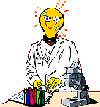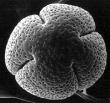Agricultural Research Service
(ARS) palynologist (one who studies pollen)
Gretchen D. Jones in College Station, Texas, thinks there is a strong connection
between pollen and what an insect eats. That's valuable information because it
can tell us a lot about how far an insect travels--and when it's best to spray
crops, for example.
 Pollen appears as tiny grains in the male
parts of flowering and cone-bearing plants. For some people, pollen means
allergies. During the spring, for example, these people may start sneezing
uncontrollably from the pollen of blooming flowers, grasses, and
trees. Pollen appears as tiny grains in the male
parts of flowering and cone-bearing plants. For some people, pollen means
allergies. During the spring, for example, these people may start sneezing
uncontrollably from the pollen of blooming flowers, grasses, and
trees.
Allergies--sensitivity to certain
substances--may be triggered by dust, mold spores, pollen, dandruff, hair and
some foods. Asthma and hay
 fever
are allergies that often begin in childhood. fever
are allergies that often begin in childhood.
Some USDA scientists are studying pollen to track
the movement and feeding habits of insects.  Scientists
examining moths and butterflies found that pollen "sticks" to various body
parts (eyes, nose, antennae and legs). The corn earworm has been found
to have pollen from the flowers of citrus, like oranges and grapefruit and
honeysuckle, on its body parts. Pollen also has been found in the insect's
digestive system after feeding on these plants. Scientists
examining moths and butterflies found that pollen "sticks" to various body
parts (eyes, nose, antennae and legs). The corn earworm has been found
to have pollen from the flowers of citrus, like oranges and grapefruit and
honeysuckle, on its body parts. Pollen also has been found in the insect's
digestive system after feeding on these plants.
 How
far do insects migrate? Pollen can provide evidence
of how far some insects travel. Pollen from Texas ebony and citrus was found on
corn earworm moths captured in Oklahoma. Since these two plant species are not
found in Oklahoma, the corn earworm moths must have eaten them in an area in
Texas or Mexico and then traveled more than 500 miles to
Oklahoma. How
far do insects migrate? Pollen can provide evidence
of how far some insects travel. Pollen from Texas ebony and citrus was found on
corn earworm moths captured in Oklahoma. Since these two plant species are not
found in Oklahoma, the corn earworm moths must have eaten them in an area in
Texas or Mexico and then traveled more than 500 miles to
Oklahoma.
"Knowing that an insect migrates into a
particular area is important for two main reasons," Dr. Jones explains. "First,
it can help farmers avoid spraying their crops with pesticide before the insect
has even arrived. Second, by knowing where the insect originally comes from,
it's possible to fight the pest there, rather than wait until it has migrated
into a crop field."
In either case, the information helps farmers
use as little pesticide as possible.
 Honey, made by honey bees, is an important food throughout the
world. The raw materials of honey are pollen and
nectar (pronounced "NECK-tar"). Pollen is the bee's source of protein, and
nectar is its source of carbohydrate. Honey, made by honey bees, is an important food throughout the
world. The raw materials of honey are pollen and
nectar (pronounced "NECK-tar"). Pollen is the bee's source of protein, and
nectar is its source of carbohydrate.
Changes in climate can be determined by studying
pollen taken from the soil of lakes. Pollen falls onto the soil and into lakes
throughout the year. Each year, another layer of pollen is added to the
pre-existing layer. As the vegetation changes, so does the pollen that's
deposited in the soil or lake. Climate changes can be determined by comparing
the pollen found in the layers to the climate in which the pollen-producing
plants grew.
Did you know that scientists can be detectives and
solve crimes
by using pollen as evidence?
 During a
European vacation along the Danube River in the Austrian capital of Vienna, a
man disappeared, but his body could not be found. The police had no evidence to
link a suspect with a possible crime until they searched the suspect's room and
found a pair of boots with mud still attached to the soles. The mud was
examined and found to contain pollen from modern spruce and willow. During a
European vacation along the Danube River in the Austrian capital of Vienna, a
man disappeared, but his body could not be found. The police had no evidence to
link a suspect with a possible crime until they searched the suspect's room and
found a pair of boots with mud still attached to the soles. The mud was
examined and found to contain pollen from modern spruce and willow.
Based on the pollen evidence, only one area
where the suspect must have walked was pinpointed. Only one location, a small
area 20 kilometers north of Vienna along the Danube Valley, had soils that
contained the precise mixture of pollen in the mud. When confronted with the
evidence, the suspect confessed his crime and showed the police where he had
killed the victim and buried the body.
Today, the country of New Zealand leads the
world in the use of forensic palynology (the study of pollen) and the
acceptance of this type of evidence in courts of law.
-- By Linda McGraw, formerly, Agricultural
Research Service, Information Staff
|